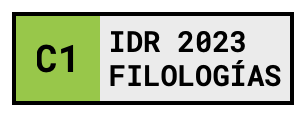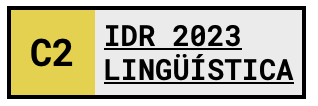La investigación de los procesos lectores: tendencias y enfoques en la lectura general y específica
Palabras clave:
reading, foreign language, academic purposes, research, trends and approaches, linguistic competence, strategic competence, interactive model, background knowledge, linguistic threshold theoryResumen
Our analysis aims to compile the trends and approaches along with some of the most meaningful works on foreign language reading from the 60s up until the present day, focusing especially on research into reading for academic purposes (RAP). We place particular emphasis on RAP, given the doubtless relevance it has held, still holds, and will continue to hold in the field of technical and scientific sciences.
Descargas
Citas
Alderson J. C y A. H. Urquhart, eds. (1984). Reading in a foreign language. New
York: Longman.
Alderson, C. y Y. Lukmani. (1989). “Cognition and reading: Cognitive levels as
embodied in test questions”. Reading in a foreign language, 5: 253-270.
Anderson, R. C. y P. D Pearson. (1998). “A schema-theoretic view of basic processes in reading comprehension”. En Carrel, P. L. et ál., eds.:36-55.
Auerbach, E. R. y D. Paxton. (1997). “It’s not the English thing”: bringing reading research into the ESL classroom”. Tesol Quarterly, 31: 237-261.
Bamford, J. y R. R. Day. (1998). “Comments on Jeong-Won Lee y Diane Lemonnier Schallert’s. ‘The relative contribution of L2 language proficiency and L1 reading ability to L2 reading performance: a test of the threshold hypothesis in an EFL context’. Tesol Quarterly, 32: 747-749.
Barnett, M. (1986). “Syntactic and lexical/semantic skill in foreign language reading: Importance and interaction”. Modern Language Journal, 70: 343-349.
Barnitz, J. G. (1985). Reading development of nonative speakers of English. Orlando, FL: Harcourt Brace Jovanovich.
Barr, R., Kamil, M., Mosenthal, P. y P. D. Pearson, eds. (1991). Handbook of reading research. New York: Longman.
Barr, R., Kamil, M., Mosenthal, P. y P. D. Pearson, eds. (1996). Handbook of reading research. New York: Longman.
Barrios Espinosa, M. E. (1996). “Schema Theory and L2 Reading Instruction”. Lenguaje y Textos, 8: 239-250.
Bentin, S., N. Bargai y L. Katz. (1984). “Orthographic and phonemic coding for lexical access: Evidence from Hebrew”. Journal of Experimental Psychology: Learning, Memory, and Cognition, 10: 353-368.
Berman, R. (1984). “Syntactic components of the foreign language reading process”. En Alderson J. C y A. H. Urquhart, eds: 139-156.
Bernhardt, E. (1987). “Cognitive processes in L2: An examination of reading behaviours”. En Lantolf J. y A. Labarca, eds.: 35-55.
Bernhardt, E. B. y M. Kamil. (1995). “Interpreting relationships between L1 and L2 reading: consolidating the linguistic threshold and the linguistic inter- dependence hypotheses”. Applied Linguistics, 16: 15-34.
Block, E. (1986). “The comprehension strategies of second language readers”. Tesol Quarterly, 20: 463-494.
Block, E. (1992). “See how they read: comprehension monitoring of L1 and L2 readers”. Tesol Quarterly, 26: 319-343.
Bloor, M. (1985). “Some approaches to the design of reading courses in English as a foreign language”. Reading in a Foreign Language, 3: 39-45.
Boyer, M., M. Butzbach y M. Pendanx. (1990). Nouvelle introduction á la didac- tique du francais langue étrangére. París: CLE International.
Bransford J. D., Stein, B .S. y T. Shelton. (1984). “Learning from the perspec- tive of the comprehender”. En Anderson J. C.y A. H. Urquhart, eds.: 28-47.
Carrel, P. L. (1984). “The effects of rethorical organization on ESL readers”. Tesol Quarterly, 18: 441-469.
Carrel, P. L. (1985). “Facilitating ESL reading by teaching text structure.”, Tesol Quarterly, 19:727-752.
Carrel, P. L. (1987). “Content and formal schemata in ESL reading”. Tesol Quarterly, 13: 461-481.
Carrel, P. L. (1989). “SLA and classroom instruction: Reading.” Annual Review of Applied Linguistics, 9: 233-242.
Carrel, P. L. y J. C. Eisterhold. (1983). “Schema theory and ESL reading ped- agogy.” Tesol Quarterly, 17: 553-573.
Carrel, P. L., Pharis, B., y J. C. Liberto. (1989). “Metacognitive strategy train- ing for ESL reading”. Tesol Quarterly, 23: 647-678.
Casanave, C. P. (1988). “Comprehension monitoring in ESL reading: a neglect- ed essential”. Tesol Quarterly, 22: 283-302.
Clarke, M y S. Silberstein. (1977). “Toward a realization of psycholinguistic principles in the ESL reading class. Language Learning, 27: 135-154.
Clarke, M. (1980). “The short circuit hypothesis of ESL reading- Or when lan- guage competence interferes with reading performance”. Modern Language Journal, 64: 203-209.
Coady, J. (1979). “A psycholinguistic model of the ESL reader” En Mackay R., Barkman B. y R. Jordan, eds.: 5-12.
Cook, V. J. (1992). “Evidence for Multicompetence”. Language Learning, 42: 557- 591.
Cooper, M. (1984). “Linguistic competence of practised and unpractised non- native readers of English.”. En Anderson J. C. y A. H. Urquhart, eds.: 122-138.
Cornaire, C. (1999). Le point sur la lecture. París: CLE International.
Crawford, B. (2003). “Metadiscourse and ESP reading comprehension: An exploratory study. Reading in a Foreign Language, 14:28-44.
Crow, J., y R. Quigley. (1985). A semantic field approach to passive vocabulary acquisition for reading comprehension. Tesol Quarterly, 19, 497-513.
Cummins, J. (1980). “The cross-lingual dimensions of language proficiency: implications for bilingual education and the optimal age issue”. Tesol Quarterly, 14: 175-187.
Damiani Costa, M. (1995). La aplicación del mapa semántico como estrategia de lectu- ra/aprendizaje para alumnos brasileños principiantes en lengua española como lengua extranjera. Tesis doctoral. Universidad Complutense de Madrid.
Daneman, M. (1996). “Individual Differences in Reading Skills”. En Barr R., Kamil M., Mosenthal P., y P. D. Pearson, eds.: 512-538.
Davies, E. y N. Whitney. (1984). Study Skills for Reading. London: Heinemann Educational.
Devine, J., Carrel, P. y D. Eskey, eds. (1987). Research in reading in English as a second language. Washington, DC: TESOL.
Diack, H. (1975). Test your own wordpower. St. Albans: Paladin.
Eskey, D. (1970). “A new technique for the teaching of reading to advanced stu-
dents.” Tesol Quarterly, 4: 315-321.
Fries, C. (1963). Linguistics and Reading. New York: Hott, Rinehart y Winston.
Gingras, R. C. (1978). Second language acquisition and foreign language teaching. Arlington: CAL.
Goodman, K. (1979). “The Know-more and the know-nothing movements in reading: a personal response”. Language Arts, 55: 657-663.
Goodman, K. S. (1971). “Psycholinguistic universals in the reading process”. En Pimsleur P. y T. Quinn, eds.: 135-142.
Goodman, K. S. (1973). “Analysis of oral reading miscues: applied psycholin- guistics”. En Smith F., ed.:158-176.
Goulden, R., Nation, P., y J. Read. (1990). “How large can a receptive vocab- ulary be?” Applied Linguistics, 11: 341-363.
Grabe, W. (1991). “Current developments in second reading research”. Tesol Quarterly, 25: 375-406.
Hee Ko, M. (2005). “Glosses, comprehension, and strategy use.” Reading in a Foreign Language, 17: 125-143.
Heimlich, J. E. y S. D. Pittelman. (1986). “Semantic mapping: Classroom applications”. Newark, DE. International Reading Association.
Holschuch, L. W. y J. P. Kelley. (1988). Academic Reading. New York: St. Martin’s Press.
Hudson, T. (1991). “A Content Comprehension Approach to Reading English for Science and Technology”. Tesol Quarterly, 25: 77-104.
Hu Hsueh-Chao, M. y P. Nation. (2000). “Unknown Vocabulary Density and Reading Comprehension”. Reading in a Foreign Language, 13: 403-430.
Johns, T. y F. Davies. (1983). “Text as a vehicle for information: the classroom use of written texts in teaching reading in a foreign language”. Reading in a Foreign Language, 1: 1-19.
Johnson, P. (1981). “Effects on reading comprehension language complexity and cultural background of a text.” Tesol Quarterly, 15: 169-181.
Jordan, R. R. (1997). English for academic purposes : a guide and resource book for teach- ers. Cambridge: Cambridge University Press.
Kaplan, R. B. y P. A. Shaw. (1983). Exploring Academic Discourse. Rowley, Mass: Newbury House.
Kern, R. G. (1994). “The Role of Mental Translation of Second Language Reading”. Studies in Second Language Acquisition, 16: 441-461.
Krashen, S. (1981). “The case for narrow reading”. Tesol Newsletter, 15: 23.
Lahuerta Martínez, A. (1997). “Una propuesta para la mejora de la compren- sión escrita en una lengua no nativa basada en la interpretación de la infor- mación retórica que presentan los textos.” En Otal, J. L, Fontanet, I. y V. Codina, eds.: 905-912.
Lantolf, J., y A. Labarca, eds. (1987). Research on second language acquisition in class- room settings. Norwood, NJ: Ablex.
Lee, J. y D. L. Schallert. (1997). “The relative contribution of L2 language pro- ficiency and L1 reading ability to L2 reading performance: a test of the threshold hypothesis in an EFL context”. Tesol Quarterly, 31: 713-739.
Mackay, R., Barkman, B. y R. R. Jordan, eds. (1979). Reading in a Second Language. Rowley, MA: Newbury House.
Mustafa, Z. (1998). “Reading for Science and Technology in a Foreign Language: Students’ Evaluation of Formal Instruction on Reading Strategies”. Reading in a Foreign Language, 11: 225-238.
Otal, J. L, Fontanet, I. y V. Codina, eds. (1997). Estudios de Lingüística Aplicada. Castelló: Publicaciones de la Universitat Jaume I.
Padron, Y., y H. Waxman. (1988). “The effect of ESL students’ perceptions of their cognitive strategies on reading achievement”. Tesol Quarterly, 22: 146-150.
Paran, A. (1996). “Reading in EFL: facts and fictions”. ELT Journal, 50: 25-34.
Parry, K. (1996). “Culture, literacy, and L2 reading”. Tesol Quarterly, 30: 665-692.
Paulston, C. B. y M. N. Bruder. (1976). Teaching English as a second language: Tech- niques and procedures. Cambridge, Massachussetts: Winthrop.
Peña Calvo, A. (1993). Las estrategias de lectura en el proceso de aprendizaje de una len- gua extranjera: acercamiento consciente al discurso escrito. Tesis doctoral. Universidad Complutense de Madrid.
Peretz, A. S. y Shoham, M. (1990). “Testing Reading Comprehension in LSP: Does Topic Familiarity Affect Assessed Difficulty and Actual Performance?”. Reading in a Foreign Language, 7: 447-455.
Pimsleur, P. y T. Quinn, eds. (1971). The psychology of second-language learning: Papers from the Second International Congress of Applied Linguistics. Cambridge: Cambridge University Press.
Rayner, K. y Pollatsek, A. (1989). The Psychology of reading. Englewood Cliffs, NJ: Prentice Hall.
Resnick L. B. y P. A. Weaver, eds. (1979). Theory and practice of early reading. Hillsdale, N. J: Lawrence Earlbaum.
Resnick, L. B. (1979). “Theories and presciptions for early reading instruction”. En Resnick L. B.y P. A. Weaver, eds.: 321-338.
Rigg, P. (1981). “Beginning to read in English the LEA way”. En Twyford C. W., Diehl W. y K. Feathers, eds.: 81-90.
Royer, J. M., Bates J. A y C. E. Konold. (1984). “Learning from text: methods of affecting reader intent.” En Alderson J. C. y A. Urquhart, eds.: 65-85.
Segalowitz, D. (1991). “Does advanced skill in a second language reduce auto- maticiy in the first language?”. Language Learning, 41: 59-83.
Silberstein, S. (1987). “Let’s take another look at reading: Twenty-five years of reading instruction”. English Teaching Forum, 25: 28-35.
Smith, F., ed. (1971). Psycholinguistics and reading. New York: Holt, Rinehart and Winston.
Soulé-Susbielles, N. (1987). “Improving students ́competence in foreign-lan- guage reading”. ELT Journal, 41: 198-203.
Stanovich, K. (1986). “Matthew effects in reading: Some consequences of indi- vidual differences in the acquisition of literacy”. Reading Research Quarterly, 21: 360-407.
Steffensen, M. S. y C. Joag-Dev. (1984). “Cultural knowledge and reading.” En Alderson J. C. y A. H. Urquhart, eds.: 48-64.
Strother, J. y J. Ulijn. (1987). “Does syntactic rewriting affect English for Science and Technology (EST) text comprehension?” En J. Devine, Carrel, P. y D. Eskey, eds.: 89-101.
Taguchi, E. y Gorsuch, G. J. (2002). “Transfer Effects of Repeated EFL Reading in Reading New Passages: A Preliminary Investigation.” Reading in a Foreign Language, 14: 43-65.
Thorndike, E. L. y I. Lorge. (1944). The Teacher’s Word Book of 30.000 Words. New York: Columbia University.
Twyford C.W., Diehl W., y K. Feathers, eds. (1981). Reading English as a Second Language. Moving from theory.
Upton, T. A. (1997). “First and second language use in reading comprehension strategies of Japanese ESL students.” Teaching English as a second or foreign lan- guage, 3:1-24.
Urquhart, A. H. (1984). “The effect of rhetorical ordering on readability”. En Alderson J. C. y A. H. Urquhart, eds.: 161-180.
Vigner, G. (1980). Didactique fonctionnelle du francais. París: Hachette.
Ward, J. (1999). “How Large a Vocabulary do EAP Engineering Students need?”. Reading in a Foreign Language, 12: 309-323.
Weber, R. M. (1996). “Linguistic Diversity and Reading in American Society”. En Barr, R., Kamil, M., Mosenthal, P. y P. Pearson, eds.: 97-119.
Widdowson, H. G. (1979). Explorations in Applied Linguistics. Oxford: Oxford University Press.
Williams, R. y D. Dallas. (1984). “Aspects of vocabulary in the readability of content area L2 educational textbooks: a case study.” En J. C. Anderson y A. H. Urquhart, eds.: 199-212.
Descargas
Publicado
Cómo citar
Número
Sección
Licencia
Aquellos autores/as que tengan publicaciones con esta revista, aceptan los términos siguientes:
- Los autores/as conservarán sus derechos de autor y garantizarán a la revista el derecho de primera publicación de su obra, el cuál estará simultáneamente sujeto a la Licencia de reconocimiento de Creative Commons que permite a terceros compartir la obra siempre que se indique su autor y su primera publicación esta revista.
- Los autores/as podrán adoptar otros acuerdos de licencia no exclusiva de distribución de la versión de la obra publicada (p. ej.: depositarla en un archivo telemático institucional o publicarla en un volumen monográfico) siempre que se indique la publicación inicial en esta revista.
- Se permite y recomienda a los autores/as difundir su obra a través de Internet (p. ej.: en archivos telemáticos institucionales o en su página web) antes y durante el proceso de envío, lo cual puede producir intercambios interesantes y aumentar las citas de la obra publicada. (Véase El efecto del acceso abierto).

Revista de Lenguas para fines específicos is licensed under a Creative Commons Reconocimiento-NoComercial-SinObraDerivada 4.0 Internacional License.






















